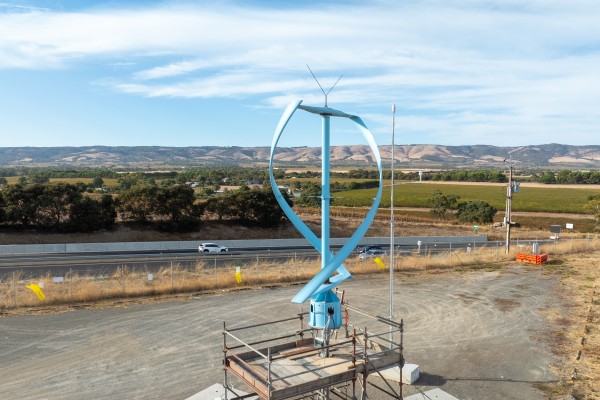Adelaide catches a breeze in turbine trial
CPB Contractors is trialling Australia’s first 6kW vertical-axis wind turbines in Adelaide, showing clean energy can be compact, quiet and simple. Casey McGuire writes.
Wind power just got a city-friendly makeover. CPB Contractors is putting Australia’s first 6kW vertical-axis wind turbines through their paces in Adelaide, providing businesses another way to add clean energy to their businesses.
ADVERTISEMENT
These compact, adaptable turbines can catch gusts from any direction, keep humming through turbulent winds and even leave a lasting green footprint in the community long after the construction crew has packed up. It’s renewable energy with a twist.
CPB Contractors is putting some serious wind in its sails with Australia’s first trial of a next-gen 6kW vertical axis wind turbine (VAWT), developed by Adelaide start-up VAWT-X Energy in collaboration with Firestone Hybrid Generators, Flinders University and a mix of private, state and federal backing.
Vertical wind technology can capture wind from any direction. With no gearbox, the turbine is directly connected to the generator shaft. It can also handle turbulent winds and still produce power.
Josh Oates-Lunn helped develop green power solutions for CPB Contractors as a qualified electrical engineer for the turbines. He provides a breakdown of the benefits of vertical wind turbines and the best environment for them to be placed.
“Vertical wind turbines can also be placed closer together, which is ideal for construction environments where we need high kilowatt per square meter generating capacity,” Josh says.
“By having smaller and more frequently distributed turbines such as this, in high wind resource areas, which Australia is full of, we can increase the generating capacity of a given area above and beyond what we may be able to achieve with solar.”
Vertical technology is also more compact and less complex, making it ideal for urban environments with lower wind quality. It can be left in place to benefit the community for years after the infrastructure project is completed.
“CPB Contractors is committed to partnering with forward-thinking people and businesses to develop solutions that allow us to leave the communities and environments where we work in a better place than when we arrived,” CPB Contractors project director Andrew Coonan says.
“We believe low-impact wind turbines like these, combined with our in-house mobile solar power supply units, have the potential to help our project sites be self-sufficient in their supply and usage of energy – making the most of the environment, so that when the sun is shining or the wind is blowing, we capitalise on this natural resource.”
This technology is built to strengthen local grids and work alongside other renewable systems. Its design allows it to perform reliably in urban areas, where wind conditions are often unpredictable.
“VAWT-X has already received enquiries from local wineries and business. This increases the market space for regional and local businesses to be involved in greening the Australian grid whilst cutting their running cost and boosting the profitability of their business,” Josh says.
It doesn’t just trim the carbon footprint, it’s a trusty backup for hybrid systems or the local grid, and when the job’s done, it sticks around to keep doing good in the community long after the crew’s packed up.
“We see the main benefit of these VAWTs as enabling the roll-out of distributed wind energy generation, which has hitherto been locked up in wind farms dependent on large scale developers and burdened by huge transmission costs,” VAWT-X Energy managing director Gary Andrews says.
“The scale of this technology, its low noise and aesthetics mean it can be brought closer to the end user and can empower the community to proactively choose wind generation as part of their energy mix.”
Whisper-quiet and built to adapt, this clean energy kit could be the construction industry’s new best mate. CPB Contractors reckon it’s got game-changer written all over it by slashing fossil fuel dependence (and the fuel-truck headache), teaming up with solar and turning work sites into their own mini power stations
“The intention was for CPB Contractors to assess the technology for ease of installation, portability and assist VAWT-X and Firestone in field testing the solution.”
The wind turbines serve multiple functions, which was a prime goal for CPB Contractors when developing the technology.
“During early mobilisation, our turbine foundations designed in-house can be placed so wind power can be used – solar takes a little more infrastructure and time to establish, whereas this wind technology can be placed on any ground conditions,” Josh says.
“VAWT-X and Firestone are assessing options but plan for the technology to scale power small towns and remote areas.”
VAWT-X Energy’s Aussie-first 6kW vertical-axis turbine packs big green power into a smaller footprint, thriving even when the wind can’t make up its mind, making it perfect for squeezing renewable energy into urban areas.
The prototype VAWT is already spinning away, powering FCA site buildings and topping up batteries, all while putting its big-commercial-dreams hat on to prove it’s ready for the big leagues.
“With a growing pipeline of renewables projects, we see enormous potential for this technology,” Andrew says.
“Not only can we generate clean energy while ensuring low-to-no impact on these regional communities, but these turbines and the energy they generate can remain beyond the project build, providing cost-efficient power for the people and businesses in these regions.”
The vertical version of the turbines isn’t claiming to be better than existing traditional turbines, but its ability to be placed closer together in areas of low-wind quality are ideal for CPB Contractors.
“This isn’t meant to solve all the problems of producing compact and low-cost power systems that the construction industry needs,” Josh says.
“It’s about adding another dimension of capability that we can use in conditions or operational situations that may lend themselves more towards this technology.”
-
ADVERTISEMENT
-
ADVERTISEMENT


